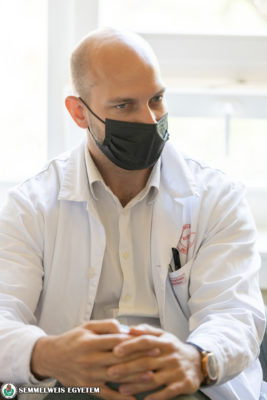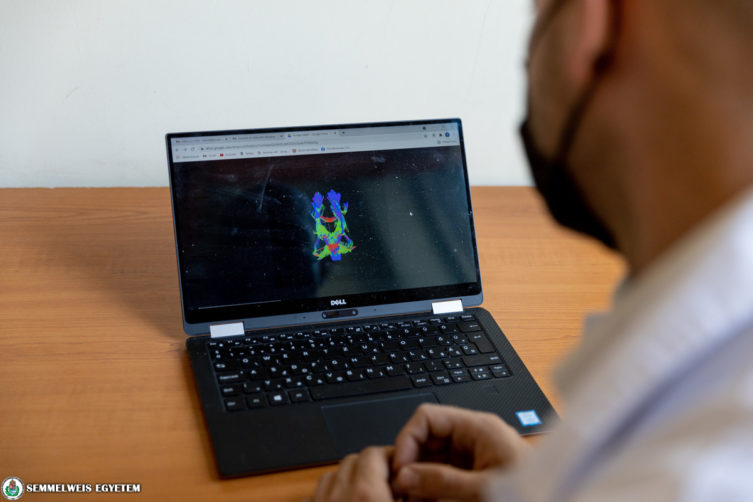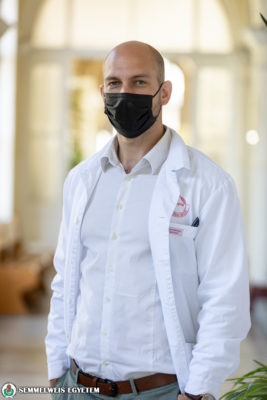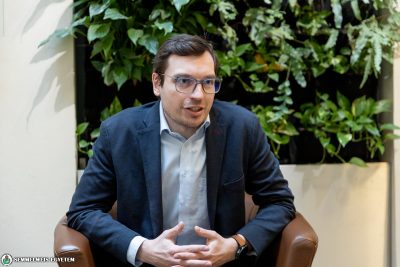Dr. András Attila Horváth, assistant professor at the Department of Anatomy, Histology and Embryology and recipient of the Junior Prima Award in the category of “Hungarian Science” leads the Hungarian subproject of a large scale European study on the prevention of dementia. The researcher, also working for the National Institute of Clinical Neurosciences, considers the recently launched project as the most significant achievement of his career so far. In our interview he talks about how his years in the Students’ Scientific Association shaped his future career and he emphasized that he is also dedicated to show the beauty of neuroanatomy and clinical research to the next generation.

“My love for biology and chemistry was decisive in pursuing a career in medicine, and my mother played an important role in this, as she taught these subjects in secondary school and at university. During my university years, I was geared towards neurosciences by the neuroanatomy course taught at the Department of Anatomy, Histology and Embryology and by the activities in the Students’ Scientific Association”, recalled Dr. András Attila Horváth, Assistant Professor, recipient of the Junior Prima Award.
His supervisor was Dr. András Csókay in the field of neurosurgery, and later he was led towards neuroanatomy by Professor Imre Szirmai. Later on, Dr. Anita Kamondi, Professor at the Department of Neurology became the supervisor of his scientific activities as a student and his PhD thesis, and through her he joined the National Institute of Clinical Neurosciences in the framework of the Hungarian Brain Research Program. The research he began here provided the basis for his PhD topic, which is the examination of the relationship between Alzheimer’s disease and epilepsy.
Currently Dr. András Attila Horváth is the Director of the NeuroCognitive Research Center of the National Institute of Clinical Neurosciences focusing on dementia and at the same time he works at the Department of Anatomy, Histology, and Embryology, where he used to be a demonstrator during his university years.
“The university is very important to me. The department is absolutely supportive in terms of both research and education. In science, it may require 20 years to get results or positive feedback, while in education student feedback is an immediate, interactive process”, he said.
Dr. András Attila Horváth also pointed out that his research activities have several elements, which are realized in the joint cooperation of the two institutes.
“An important principle of modern medical research is to bring basic research and clinical research closer together, which is greatly supported by my dual position. Clinical research involving patients is very important for me, because I can see how rapidly we are able to transfer knowledge to patient care. However, the ideas come from basic research. For example, what we have been able to demonstrate in the connection between Alzheimer’s disease and epilepsy was based on previous observations in animal models. Currently there is a joint research project with the Department of Conservative Dentistry along similar principles, which focuses on the role of inflammation in Alzheimer’s disease”, said Dr. András Attila Horváth.

According to the laudation prepared for the occasion of the Junior Prima Award, the most outstanding impact of Dr. András Attila Horváth’s scientific achievements is the change of perspective. According to this, electrophysiological phenomena appearing in cognitive disorders, which were previously considered to be benign and measurable by EEG, can be interpreted as signs of the neural over-activation of the cortex, and may represent a common drug target.
The awardee considers the most significant achievement of his career so far that he won a European Union grant in 2020 as a research leader, which includes the National Institute of Clinical Neurosciences and Semmelweis University’s Department of Psychiatry and Psychotherapy as consortium members. As part of this, research work began in January 2021, focusing on the prevention of dementia based on a Finnish example (Finnish Geriatric Intervention Study to Prevent Cognitive Impairment and Disability, FINGER).
The baseline Scandinavian follow-up study started in early 2010 and researchers found that a quarter or a third of those patients, who belong to a high-risk category for dementia had a reduced chance of developing the disease with the help of certain changes in medication and lifestyle (diet, physical activity, cognitive training, etc.).
“Almost 50 million people are affected by dementia worldwide. Therefore, it is evident that even if prevention is successful in only every fourth patient, that means more than ten million patients globally. But it is also a significant number in Hungary, as 2-300 thousand people are affected by this type of disease”, emphasized Dr. András Attila Horváth.
“Dementia, like common illnesses, has strong genetic determinants, but today environmental factors seem to be more dominant. For this reason, good results may be achieved with early prevention”, he pointed out.
In the EURO-Fingers study, 7 European countries– including Hungary – are studying how the Scandinavian disease prevention models can be applied in this geographical region and how much modification they need.
The main risk factor for dementia is old age: over 65, the number of cases doubles every 5 years. The aim of the researchers is therefore to include as many people over 65 in the study as possible from Hungary as well. At one point in the project, each participant undergoes the complex assessment of the nervous system. At present, it is also possible to participate in an online research related to the coronavirus, which is part of a study involving 70 countries to determine whether COVID-19 infection has a negative impact on cognitive functions.

Dr. András Attila Horváth considers it extremely important to have participants in the dementia-related research projects from all over the country. Therefore, a Dementia Prevention Platform has been set up with the Research Center for Natural Sciences of the Eötvös Loránd Research Network, in which they would like to involve all the four medical universities, but it is also open to other hospitals.
Dr. András Attila Horváth emphasized that 10 students from Semmelweis University are working in his research team, and the number of PhD students is remarkable as well. He believes that lecturers can play a decisive role in shaping the interests of the young generation, just like it happened to him. He is also dedicated to showing the beauty of neuroanatomy to the next generation, as well as the role of neuroscience research in ageing societies.
Pálma Dobozi
Photo: Attila Kovács – Semmelweis University
Translation: Katalin Illés-Romhányi


